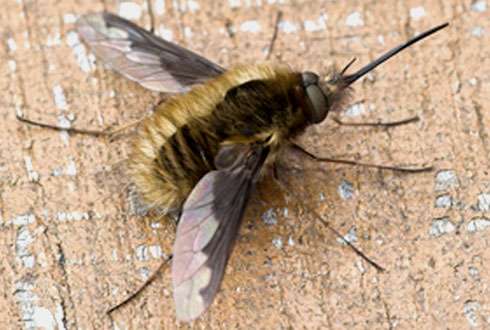Bee-flies and false widow spiders top Museum enquiry

Do bee mimics sting or arachnids bite are the most frequent questions put to our identification experts.
Pass by the offices of the Museum's Identification and Advisory Service (IAS) this month and you're quite likely to spot someone clutching a jar containing a bee-fly.
Even though the large bee-fly, Bombylius major, is fairly common in gardens and woodland in southern Britain, particularly during the spring, people are intrigued when they see what looks like a hairy bee with a high-pitch hum and frequently ask the Museum to identify them.
'People are spotting more of these flies that look like bees in their gardens, not because they're becoming more common,' said Museum fly expert Erica McAlister, 'but because the public are generally more aware of bees because we know there's a shortage of them.'
Large bee-flies fly from late March to the end of May and look like a cross between a bee and a giant mosquito. Even though they have a long thin tongue (proboscis) that looks like it could hurt, bee-flies do not sting nor spread disease and are harmless to humans.
The long proboscis is actually used for feeding on flower nectar. These bee mimics hum and hover in front of flowers like bees but, unlike bees, when they feed they perch on the flower with their long legs.
The other main difference between the two is that bee-flies have a single pair of wings, whereas bees have two.
'I have a large soft (and fluffy) spot for these flies,' Dr McAlister wrote in her blog last year. 'They have the most fascinating ecology. They're parasites of bees and wasps, they're some of the earliest flies to emerge in the season and, I think, some of the most attractive.
'They are often very hairy and fly low down to the ground. There have been sightings near the Museum and I can't wait to see one. But hurry as they are early season fliers and they like warm and sunny days.'
There are nine species of bee-fly in the UK. Bombylius major, the most common, has a strong dark mark across the front half of its wings. The rarer Bombylius discolor has a spotty wing edge.
The adults search for nests of solitary bees, wasps and beetles and when they find one, hover near the nest entrance and dip their abdomen into the surface of the soil to lay their eggs. The hatched larvae then lives off (parasitises) the bee, wasp or beetle larvae.
During the autumn, false widow spiders replace the bee-fly as the most popular request by the public for identification from the IAS.
False widow spiders, of which seven species have been recorded in the UK, are among only a dozen or so of the UK's 650 species of spider that are capable of biting humans. But spider bites are extremely rare within the UK.
'Even in homes with several resident false widow spiders you are statistically far more likely to be stung by a wasp or bitten by a dog,' said Stuart Hine, Manager of the IAS.
Provided by Natural History Museum


















